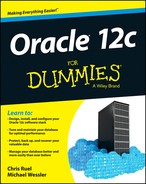Oracle 12c For Dummies®
Visit www.dummies.com/cheatsheet/oracle12 to view this book's cheat sheet.
Table of Contents
Part I: Getting Started with Oracle 12c
Chapter 1: Discovering Databases and Oracle 12c
Finding the right database for the job
What is the “c” in Oracle 12c?
Keeping a Database Safe and Sound
Chapter 2: Understanding Oracle Database Architecture
Defining Databases and Instances
Deconstructing the Oracle Architecture
Walking Down Oracle Memory Structures
Trotting around the System Global Area
Following the Oracle Processes
Data files: Where the data meets the disk
Server and initialization parameter files
Applying Some Logical Structures
Chapter 3: Preparing to Implement Oracle
Understanding How an Oracle Database Fits into a System’s Architecture
User and directory requirements
Part II: Implementing an Oracle Database
Chapter 4: Creating Your Database
Feeling at Home in Your Environment
Finding the Oracle software owner
Setting your environment with oraenv
Setting parameters in the pfile and spfile
Using the Database Configuration Assistant (DBCA) to Create Databases
Doing a Post-Creation Check-Up
Chapter 5: Connecting to the Database
Starting and Stopping the Database
Connecting to the Database Instance
Local versus remote connections
Configuring the database listener with listener.ora
Starting and stopping the database listener
Oracle Net Configuration Assistant
Sidestepping Connection Gotchas
Chapter 6: Understanding the Language of Databases: SQL
Case sensitivity in the database
Viewing your objects and data with the DESCRIBE and SELECT statements
Add to your data with the INSERT statement
Changing data with the UPDATE statement
Removing data with the DELETE statement
Chapter 7: Loading Data into Your Database
Understanding Users and Schemas
Part III: Caring for and Feeding an Oracle Database
Chapter 8: Keeping the Database Running
Monitoring space in your segments
Automating Chores with the Oracle Scheduler
Creating your first Scheduler job
Using Data Pump with a Parameter File
Chapter 9: Tuning an Oracle Database for Performance
Tuning the Database before Something Goes Wrong
Pre-installation planning and preparation
Tell me, what is your problem?
Displaying and reading the SQL statement output
Taking snapshots with STATSPACK
Chapter 10: Securing and Auditing Your Database
Staying Authentic with Authentication
Operating system authentication
Granting and revoking system privileges
Auditing: Oracle’s Big Brother
Enabling and disabling audits with unified audit policies
Chapter 11: Facilitating Backup and Recovery
Understanding Threats to Your Database
Finding Files with Recovery Manager
Enabling the Fast Recovery Area
Recovering Your Oracle Database
Recovering your database with copies
Chapter 12: Troubleshooting an Oracle Database
Troubleshooting with System Methodology
Performing basic system checks
Performing basic database checks
Developing and applying a solution
Troubleshooting Using Oracle Database Logs
Benefiting from Other Diagnostic Utilities
Oracle Enterprise Manager and Database Express 12c
Chapter 13: Managing Your Database with Enterprise Manager
Getting to Know the Enterprise Manager Family
Configuring EM Database Express with the DBCA
Navigating EM Database Express
Creating and Managing EM Database Express Users
Part IV: Advanced Oracle Technologies
Compressing Data for Purging, Retention, and Archiving
Multitenant Architecture and Pluggable Databases
Creating a multitenant database environment
Navigating a multitenant architecture
Starting and stopping pluggable databases
Unplugging and plugging in your PDBs
Chapter 15: Using High-Availability Options
Gathering Real Application Clusters
Hardware considerations for RAC
Software considerations for RAC
Tools for managing a RAC installation
Oracle RAC application for high availability
Understanding Oracle Data Guard
Performing switchover and failover operations
Chapter 16: Ten Oracle Installation Do’s
Observe the Optimal Flexible Architecture
Chapter 17: Ten Database Design Do’s
Know Basic Data Modeling Skills
Watch Your Roles and Privileges
Avoid Having Too Many Cooks in the Kitchen
Appendix A: Installing Oracle 12c on Linux
Checking your operating system version
Creating Linux OS groups and users
Creating the ORACLE_BASE directory
Configuring the Oracle user environment
